Artist Profile
Frida Kahlo
Born – 6 July, 1907, Coyoacán, Mexico City, Mexico
Died – 13 July, 1954, Coyoacán, Mexico City, Mexico
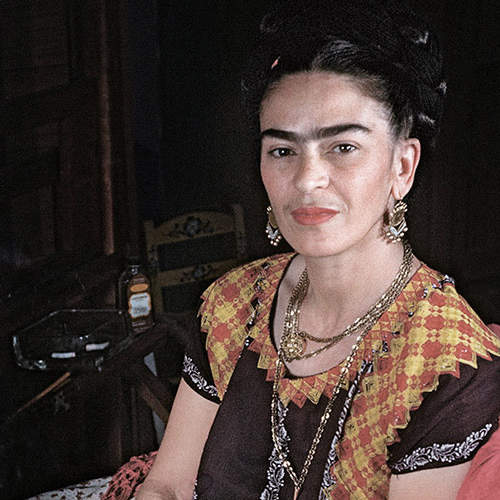
Artist Profile
Frida Kahlo
Born – 6 July, 1907, Coyoacán, Mexico City, Mexico
Died – 13 July, 1954, Coyoacán, Mexico City, Mexico
The artist Frida Kahlo is celebrated in Mexico for her attention to Mexican and indigenous culture and by feminists for her depiction of the female experience and form. She nearly died in a bus accident as a teenager and this incident influences a lot of her work.
Early Life
Magdalena, Carmen Frida Kahlo Calderon was born on the 6th of July 1907, in Coyoacan, a suburb of Mexico City. She was the third daughter of Matilda and Wilhelm Kahlo, who was a German immigrant. Frida’s mother was kind and intelligent, but Frida also described her as calculating, cruel and fanatically religious. In contrast, in her diary, she described her father, who was an amateur artist, as warm, affectionate and sympathetic to her problems.
In 1913, at the age of six, Frida Kahlo contracted polio, which left her with a slightly crooked right foot. As a result, school children called her ‘Peg Leg Frida’. So, it was not surprising that she took to wearing trousers and very long skirts.
At the age of 15 Frida was one of 35 girls to join the first intake of girls at the 2000 strong National Preparatory School in Mexico City. Frida specialised in natural sciences because she wanted to be a doctor. She was an avid reader, a strong supporter of social justice and became seriously committed to Mexican culture and politics. It was at the National Preparatory School that she first saw the artist Diego Rivera, who she often teased as he was painting the fresco ‘The Creation’ in the Simon Bolívar Amphitheatre within the school.
Serious Injury
On the 17th of September 1925 Frida Kahlo was seriously injured in a collision between a tram and the bus she was traveling home from school on. She spent a month in the Red Cross Hospital and during the long months of convalescence that followed, she began to paint. “I felt I still had enough energy to do something other than studying to become a doctor without giving it any particular thought, I started painting”.
A canopy was attached to Frida’s bed with a mirror covering its entire underside, so she could see herself and be her own model. This was the start of the many self-portraits that dominate Frida Kahlo’s work. “I paint myself because I’m so often alone and because I am the subject I know best.” As an artist, she was virtually self-taught, but she did have drawing lessons from the commercial printmaker Fernando Fernandez, whose studio happened to be close to her school.
To express her very individual ideas and feelings Frida Kahlo developed her own pictorial language. She used symbols which once decoded, offer insights into her paintings and the circumstances surrounding their creation. Her imagery was heavily influenced by Mexican popular art and pre-Columbian culture.
Frida Kahlo meets Diego Rivera 1927
He was overwhelmed by her determination and passion and impressed by her work. He encouraged her to pursue a career as an artist and soon became a frequent visitor to Frida Kahlo’s home. They fell in love and in his mural, The Ballad of the Revolution, he painted Frida wearing a red blouse with a star on the breast, distributing weapons for the revolutionary struggle. Frida had joined the Young Communist League in 1927 and became a member of the Mexican Communist Party in 1928.
On the 21st of August 1929, Frida Kahlo and Diego Rivera were married, he was 42 and she was 22. Her parents were very much against the marriage often referring to the couple as the ‘Elephant and the Dove’. Before her marriage Frida had often worn men’s clothes as a means of establishing her independence, but when with Diego, she took to wearing the richly decorative dress of the women from Teheuantepec region. This became her preferred clothing, partly because the floor length skirts hid her somewhat shorter right leg. Frida left the Communist Party in 1929 because Diego had been expelled from it.
The move to America
In 1930 Diego was offered a commission to paint a mural in the United States and in November of that year the couple moved to San Francisco. The United States was a powerful magnet for Mexican mural painters because under the Presidency of Plutarco Elias Calles, the funding for murals had virtually dried up, and political opponents, especially communists, had been imprisoned. Later that year Frida Kahlo’s first pregnancy was terminated because of problems with her pelvis resulting from the injury sustained in the traffic accident. The pain and the deformity of her right leg also became more problematic and led to the meeting with Dr Leo Eloesser, who would become her most trusted medical adviser. 1932 saw Frida and Diego move to Detroit, but in July of that year, Frida’s second pregnancy ended in miscarriage. She recorded the traumatic event in this painting called Henry Ford Hospital.
Later that year the couple moved to New York, where Diego began a mural at the Rockefeller Centre. But problems arose. Frida Kahlo had had enough of America and Americans and wanted to return to Mexico, but Diego was fascinated by the country and wanted to stay. In reaction to the conflict, Frida began work on ‘My Dress Hangs There’ which she completed later in Mexico. Her view of America can be seen in the symbolism of social decay and human values depicted in the picture. Ironically, Diego’s contract in New York was cancelled early, because he had given a figure of a worker’s leader in the mural the face of Lenin.
Unfortunately, in 1934 Frida’s third pregnancy was terminated and her right foot was operated on and several toes are removed. Early the following year Frida left home after discovering Diego’s affair with her younger sister, Christina. For several months Frida lived in an apartment in the centre of Mexico City and had a short-lived affair with the American sculptor, Isamu Noguchi.
Politics
But in 1936, after a reconciliation with Diego, Frida moved back into the family home and had yet another operation on her foot. Later that year, the Spanish Civil War broke out and she together with other sympathisers, founded a Solidarity Committee in aid of the Spanish Republicans.
Mexico granted political asylum in 1937 to Leon Trotsky, the Russian revolutionary who radically opposed to the Russian leader, Stalin. When Leon Trotsky and his family arrived in Mexico Frida met them and placed the Blue House in Coyoacan, the Kahlo family home, at their disposal. There followed a brief affair between Frida and Leon and after the relationship ended, she gave him this painting.
A Sense of Independence
1938 saw Frida Kahlo’s first exhibition, held in Julian Levy’s Gallery in New York. It was a great success. Frida’s work was so personal she found it difficult to understand others could appreciate her work. However, when the American actor Edward G Robinson purchased four of her paintings for $200 each, she saw an opportunity. “This way I am going to be able to be free. I’ll be able to travel and do what I want without asking Diego for money”.
In 1939, Frida and Diego were divorced. Subsequently, Frida suffered long periods of loneliness and threw herself into her work because she wanted no financial support from Diego. “I will never accept money from any man till I die”. She cut her hair very short, destroying, she believed, the symbol of feminine beauty and sensuality Diego so admired. She also gave up wearing long skirts and instead wore men’s suits. Some were so big, they may well have come from Diego Rivera’s own wardrobe.
Frida travelled to San Francisco in 1940 for treatment from Dr. Eloesser for severe back pain and in December of that year Frida and Diego were married for a second time. However, she did insist on paying half the household bills and from the sale of her paintings, she supported herself financially. Frida and Diego moved into the Blue House in Coyoacan in 1941 after Frida’s father, Wilhelm died. Although Diego used a house in San Angel as his studio. Following the International Exhibition of Surrealism, held the previous year in Mexico City, Frida’s reputation as an artist began to grow.
Growing Reputation
In 1943, she accepted a professorship at La Esmeralda School of Art in Mexico City. But instead of working from plaster models and copying European ideas, she sent her students out into the streets, to take their inspiration from reality of Mexican life. Frida’s unorthodox teaching methods surprised many of her students. One said, “the only help she gave us was to stimulate us, nothing more. She taught us to love people and get a taste for popular art”. Unfortunately, Frida’s health was failing and after a few months she was forced to hold her classes at home. 1945 saw Frida receive a national prize from the Ministry of Public Education for her complex painting ‘Moses’.
By 1946 her paintings were appearing in the majority of group exhibitions held in Mexico. But later that year, she went to New York for an operation to strengthen her spine. After the operation she completed this self-portrait for her patron, the engineer, Eduardo Safa. “I have almost finished your first painting, which of course is nothing but the result of the damned operation. I am sitting on the edge of an abyss – with my leather corset in one hand.”
Hospitisation
Frida re-joined the Mexican Communist Party in 1948, but two years later, in 1950, had to have a total of 7 operations on her spine and spent 9 months in the ABC hospital in Mexico City. It would not be until November 1950 that she started paint again for around 3 hours a day, using a special easel mounted on her bed. Although she was still intimate with Diego, her closest relationships from then on seem to be almost exclusively with women.
After her discharge from hospital in 1951, she was mostly confined to a wheelchair. She was in severe pain and took pain killers regularly. Up to this point her paintings had been executed with extreme technical precision. But the increasingly strong medication began to affect the steadiness of her hand, resulting in her brushwork becoming much looser, cruder and almost careless.
But in 1953 Lola Bravo organized Frida Kahlo’s first solo exhibition in Mexico in her gallery in Mexico City. Frida was in very poor health but insisted on attending the opening night. She had her bed sent to the gallery and she arrived in an ambulance. But later that year, to relieve severe pain, Frida’s right leg was amputated below the knee, which sent her into a deep depression. However, it did not stop her painting. Her work became blatantly propagandist, more so than in previous years, revealing an almost religious faith in Communism. “My painting is not revolutionary, so why should I kid myself that I am a militant”.
The End Approaches
Frida Kahlo’s end was approaching and early in 1954, she caught pneumonia. But on 2nd July 1954 while convalescing and against the advice of the doctors, she took part in the demonstration against the overthrow by the CIA of the government of Guatemalan President Jacobo Arbenz. “They amputated my leg 6 months ago, they have given me centuries of torture and at moments I have lost my reason. I keep on wanting to kill myself. Diego is the one who holds me back, because of my vanity in thinking that he would miss me”. The very last entry in her diary reads. “I hope the exit is joyful. And I hope never to come back.”
Frida Kahlo was in extreme pain on night of the 12th of July 1954 and died the following morning. Her nurse stated that Frida was prescribed a maximum of 7 pain killers but had taken 11. No autopsy was performed and that afternoon her coffin was placed in the entrance hall of the Palace of Fine Arts in Mexico City attended by a guard of honour. But like so many of her public appearances this very last one also caused a stir. With Diego Rivera’s permission, some of her political friends covered her coffin with a red flag emblazoned with a hammer and sickle and framed by a white star. This provoked a public outcry, but the guard of honour was maintained for a day and a night and by the afternoon of the 14th of July more than 600 people had paid their respects.
Frida Kahlo’s body was carried through the town to the crematorium. And after several speeches, she was cremated. Her ashes were placed in a pre-Columbian vase which now resides in the Blue House. Four year later, in accordance with the wishes of Diego Rivera who died in 1957, Frida Kahlo’s home, the Blue House, was bequeathed to the Mexican nation and opened as a museum.
Frida Kahlo was a most remarkable woman whose lust for life was focused on the idea of being very honest with and about herself. Her artistic achievement is perhaps best summed by the words of Diego Rivera. “She’s the first woman in the history of art to treat, with absolute uncompromising honesty, one might even say with impassive cruelty, those general and specific themes, which exclusively affect women.”
Frida Kahlo’s Artwork

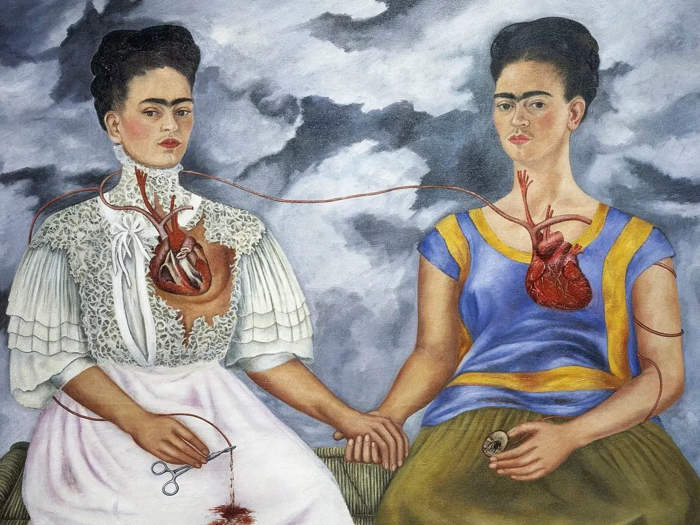
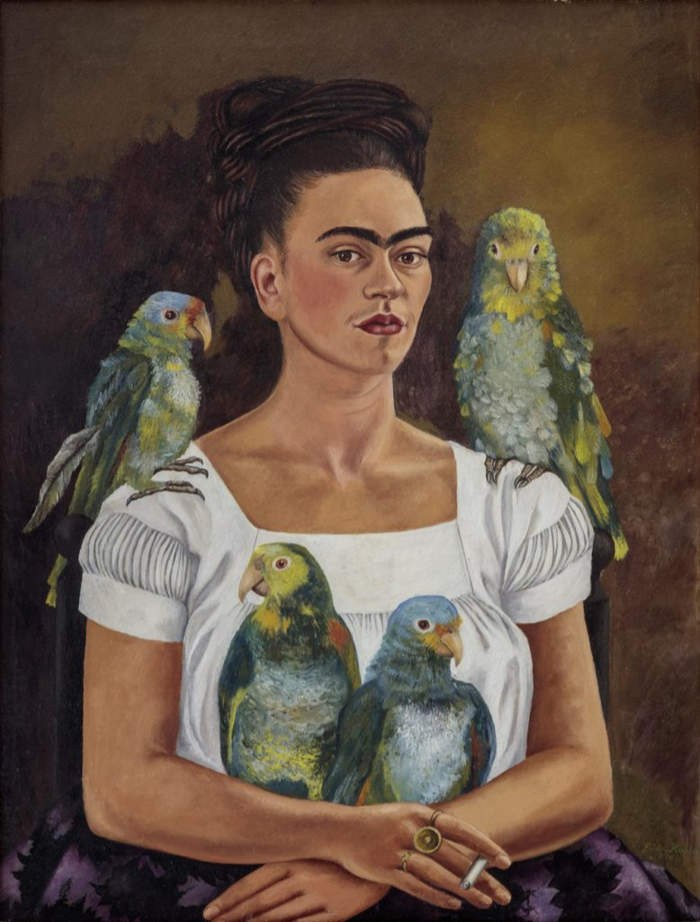
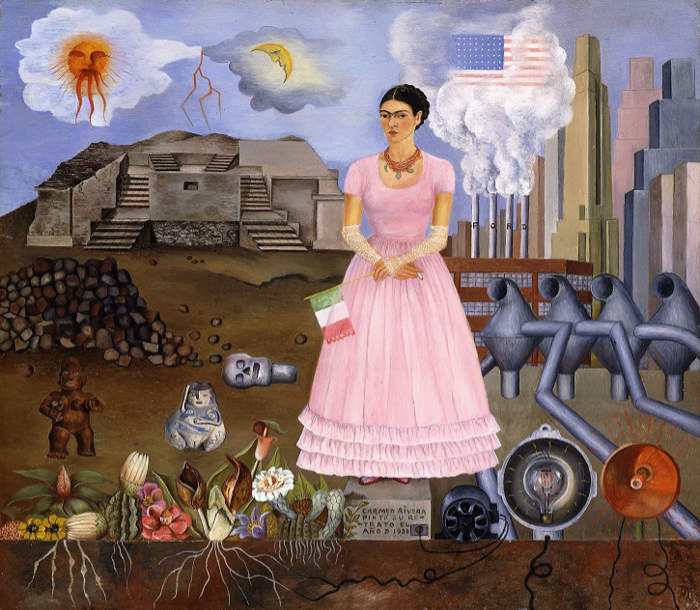
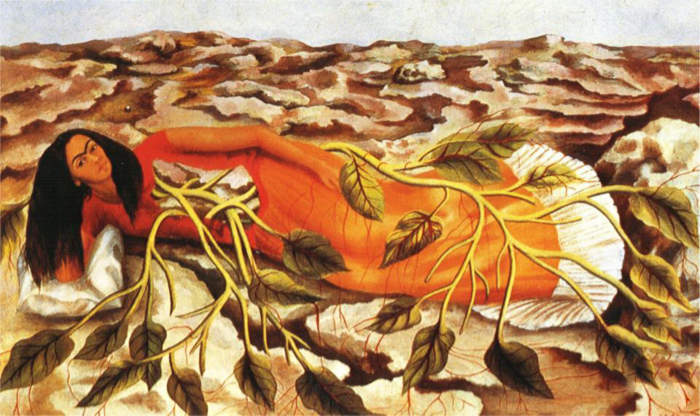

Leave A Comment